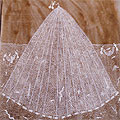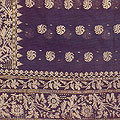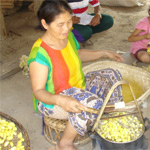Unique to Kashmir due to the large numbers of walnut tree /Junglas regia groves this craft exemplifies the finesse of craftsmanship. Locally known as dun or akhrod, the pattern is first etched on to the wood by the naqqash, master carver, and then the carving commences with those areas that are not part of the design being removed with the help of a range of chisels and a wooden mallet. Several carving technique are employed including deep etching of two inches that is usually used for complex dragon and flower motifs; half inch shallow carving used for all over flat surfaces; open or lattice work carving usually picturing the chinar leaf motif; and the semi-carved technique wherin a fine border encloses an intricately carved central motif with the grain of the wood polished as part of the design. While used earlier in the building trade with wall panels, doors and windows with elaborate walnut carvings to be glimpsed across Kashmir in traditional homes, shrines and mausoleums like the shrines of Noor-ud-din-Wali at Charar-e-Sharif, the Naqshaband mosque and the shrine of Nund Rishi; the craft for contemporary markets includes boxes, trays ladles, bowls, etc.
Waraq Printing is a process wherein gold or silver leaf is applied on to the textile through a transfer technique using blocks. This unique process demonstrates the versatility of the craftsperson's, their technical virtuosity and their in-depth knowledge of material. Waraq printing is a technique whose history is obscure and there is no real evidence as at which period it came into fruition, though all indications point to the probability that it was developed or introduced during the reign of Mughals.
Waraq has many uses, including its use in Ayurveda and as an edible food embellishment, used to adorn the Indian sweets, making them look rich and opulent. Waraq for textiles is made from a thin fine sheet of 2mm to 25mm thickness of silver or gold, depending upon the quality of waraq required, as the cost and quality of the finish increases as the waraq gets thicker.
Simple but expressive, Warli paintings are traditionally composed by the Warli community as an offering to God. Rice is pounded into a powder and mixed with water or milk to use as the paint. The painter fills the canvas with simple but dominant brush strokes that depict Warli stick figures immersed in their agrarian culture and village life. [gallery ids="176579,176581,176582,176583"]
Warlis are tribals who live in Thane district in the hinterland of Maharashtra, in simple dwellings of clay and reed plastered with cowdung. Basically tillers of land, the tribals have deep faith in their own deities which they depict in various forms. At weddings, festivals, ceremonies, and births, their homes are decorated with a wide range of symbolic patterns, asking for the continued benevolence of the gods. This tradition has given rise to Warli paintings. The mud walls are first smeared with a paste of cowdung. When this dries a coating of red mud or gheroo is applied to give body and texture to the background. Pounded rice mixed with milk and water and red sindur are applied with a brush made from the twigs of trees. Simple folk symbols drawn with bold, easy strokes are dominant. Simple diagonal, vertical, and horizontal lines form the design. Triangles are created and beautified by the addition of trees, animals, human forms, the sun, and the moon, forest, huts, and implements. White is the colour in which the image of the goddess is created since this colour is held to be sacred and pious. Other figures are drawn in the red and yellow since these are easily available in the form of turmeric and the red kumkum powder. The sacred pictograph is executed in rice-paste with a straw. The Warli paintings are simple but expressive. The commercial paintings done on paper or on cloth are executed with white poster paint on a dark background made of cowdung or mud mixed with glue. This remains the only adaptation. Stylistically, they remain unvaried and as powerful as the paintings originally drawn on walls.
Traditionally, on the second day of the Gaijatra festival in Nepal, mataya - literally the 'festival of lights' - is celebrated in Lalitpur. On this day devotees go around the city worshipping the images of the Buddha and the stupas, and among the offerings made are wax-flowers, symbolic of the leaves of the bodh tree under which the Buddha attained enlightenment. A number of wax flowers are attached to bamboo sticks and are then stuck into pulpy fruit. The fruit is pierced with a big wooden handle to make it easy to carry around in the mataya procession. However, wax flowers are now a rare sight even at the mataya festival. The making of wax flowers was a specialised task entrusted to the thakarmis (metal casters) of Lalitpur. At the mataya procession, increasingly, one sees lit wax candles on silver stands being carried around.
Bhutanese women weave beautiful handloom textiles with intricate patterns on the back strap, treadle and card looms, using a variety of yarns, in rich, vibrant colours. The vivid colours are obtained both from chemical and natural, vegetable and herbal dyes. Weaving is prevalent throughout the kingdom and traditionally it was the lady of the house "nangi aum" who had to see to the dyeing and weaving process in addition to her household duties. The entire process of weaving a fabric - from the spinning of yarn, the dyeing and final weaving was done by hand, at home. Every fabric has a name, which describes its particular combination of fibre, colour and pattern. Material could be either striped or checked. Extra motifs and patterns are obtained by supplementary weft threads or by adding warp threads. All patterns have a symbolic meaning: the tree, the swastika the wheel, the vajra, the diamond, etc. Thus, checked woollen material is called mathra, serthra or tsangthra depending on its colour. Women's dresses with a white background covered with brocade designs of silk are called kishuthara, and those with blue background are called onsham. Material with a yellow background and green and red stripes with additional warp patterns is mensimathra. Textiles in Bhutan are highly regarded, not only as a form of wealth or a commodity of value to pay taxes - but have a non verbal language of their own and convey the social identity of the wearer, are an expression of religious devotion and gifts of cloth are used to mark important occasions such as marriages or promotions.
- Shardang thara or 'striped woman's dress' is a local pattern showing multicoloured warp stripes on a white field
- Samkhongma has narrow red-and-blue warp stripes on a white field
- Mondre ('Mon or Bhutanese dress') has a pattern similar pattern to the Samkhongma and is worn mainly by the older people in rural areas.
- mense mathra: Yellow pattern band on a red field
- lungserma: Green and red pattern bands between colourful warp striping
- montha: blue or black and red pattern bands between colourful warp striping
- dromchu chema: red, green, yellow, and white pattern bands.
- jadrichem, or jadrima multicoloured warp stripes in any version of the above cloths

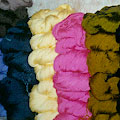
- a common nettle grass (Girardinia palmate)
- the stalk of Cannabis sativa (hemp), which grows wild in much of Bhutan and
- a tree bark.
- soaking the plant stalks, sometimes boiling them
- shredding them for twisting into yarn with the aid of a drop spindle.
- wild silk (bura)
- cultivated, reeled silk(seshu)
- Khaling silk (varieties of silk imported from Assam) and
- parachute silk (namdru kiip).
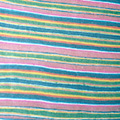
| Wool: | Dye-to-fibre ratio is two to one Yarns are soaked first in a solution of hardwood ash |
- Black and brown dyes: Walnut bark and husks, and the sour fruit of a tree called chorgenshing, mud mixed with a poisonous root (chukchume in Bumthang)
- Yellow: Leaves called photorshing
- Red: red is obtained from the purple skinned berries of thorn bushes (kipetsang)
- Light blue and purple: pine cones found over 3,000 m
- Cream / wood colour - Oak
- Mordants are substances that fix a dye on a yarn by combining with the dye. Traditional mordants include the Symplocos leaves, alumaceous earths, and sour fruits, pomegranate skin, crab apples.
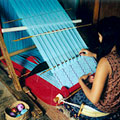
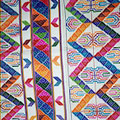
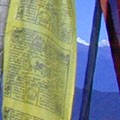
- The Goendhars are the smallest flags and hung on the tops of houses, invoking the protection of the guardian deity of the Bhutanese, Mahakala. The Goendhar is a plain white strip of cloth with red, green, blue and yellow stripes running across it - representing the various deities and elements.
- The Lungdhar and the Manidhar line the ridges and the other high grounds. Both have religious text printed on them. The Lungdhar or the wind flag is raised by a person for the invocation of the gods, for good luck, on release from an illness or misfortune or as prayer and gratitude for an achievement or any other reason. The name an age of the person is printed on the flag along with the exact reason why a flag is being raised. The colour of the flag depends on the sign of the person and astrological calculations are made for the auspicious time, direction and location of the flag.
- The manidhar or the prayer flag is raised when a family member. They act as prayers for the departed - for cleansing their sins.
- The largest flags are the Lhadhars or god flags - these can be seen outside dzongs and other important places and represent victory over evil.

The genius of the weavers was in the creation of exquisite woven textiles and the best of Bangladesh's textile remains in the variety of its woven fabrics. Extract from the monograph written by James Taylor, a medical officer posted in Dhaka from 1828-46, published by the Royal Society of Arts, "The cotton plant in this region was cultivated with special care and yielded a ball with a very fine fibre and long staple. The spinning of the thread is done by the women of the villages - the supple fingers of the younger women providing the best yarn. The weaving was done by the men. Before setting up the loom the warp threads were steeped in a rice paste to make them firm enough to withstand the tension of weaving and the humid climate kept them supple as the work progressed. For cleaning and carding the cotton balls in preparation for spinning the women used the jawbone of the boalee fish. The small, finely spaced teeth were perfect for the job and this ancient tool has never been surpassed."


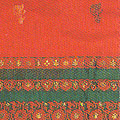
I. TEXTILES INTRODUCTION “Oh my dear heart! How ardent is my wish to have you weave on the landing of my stairs. How I wish to have you to weave silk at the foot of the loom, Having you weave an ikat sinh, and feed silk worms at my house. O, My dear young man! Going with you I dare not Because I don’t know how to weave “khid” pattern fabrics for you to sell, I cannot weave horse blankets for you to sit on As you ride on your trade expeditions
- A Traditional Courtship Song, Legends in the Weaving
“Most of the cloth woven in Laos is for personal use rather than commercial gain. Women weave their lives, hopes and aspirations into textiles. Dreams of a good husband, many children, fertile fields, and protection from harm and ill fortune are all reflected in their cloths. To weave powerful motifs on to a cloth is a reflection of the weaver’s belief that these motifs will do more than merely decorate the cloth, writes Mary Connors in Lao Textiles and Traditions.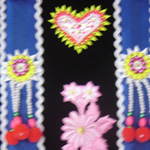



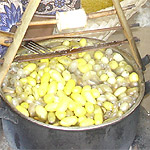
- Rearing of the silkworms: The young silkworms are fed freshly gathered and finely chopped mulberry leaves for about a month. At this stage they begin to change colour, and are ready to spin the silk fibre. From here on, the worms are closely watched so as to ensure they do not chew their way out of the cocoon, thus breaking the silk fibre.
- Reeling of silk fibres: A pot of water is placed over a hot fire. The temperature is controlled to facilitate the releasing of the filament once the cocoons are placed in the water and reeling starts. Ten to twenty cocoon filaments are drawn up at a time and reeled into a single strand. These strands are then reeled on to spools, later to be rewound into skeins.
- Grading of silk fibre by thickness and quality: Each cocoon can yield three grades of yarn which is naturally yellow. The first variety of fibre is darker coloured and of thick and poor quality; the next variety is paler and firmer; the innermost variety is soft and fine and pale in colour.
- Spinning the silk thread: is done by hand.
- Dyeing the threads – The silk yarn is first bleached with lye and then dyed. Silk is absorbs natural dyes more readily and achieves a bright hue, lending its own shine to the colour.
- Preparing the threads and setting up the loom and weaving the cloth. The weaver manipulates the threads, shuttle and other moving parts of the loom entirely by hand.
| TREES NATURAL SOURCE | PART OF THE TREE | COLOUR | OTHER USES |
| Kapok | Seed pods the ash from its bark | fluffy fibre for stuffing mattresses and pillows makes lye, an integral part of indigo dying. | |
| Wild lime trees | seeds (fruit) and wood | orange | also used as foodstuff |
| Turmeric andSugar-cane | root | yellow | |
| Areca palm | nuts | wood for dye | ‘betel nut’ chew |
| Ebony | seeds and wood | black | |
| Indian trumpet tree | bark | khaki | |
| Indigo Indigofera tinctoria) | leaves | blue Indigo | |
| Sappan | wood | pink | |
| Jackfruit and Breadfruit | wood | gold | |
| Coccus iacca Sa tree-boring insect) | resinous secretions or lac of the insect | red |
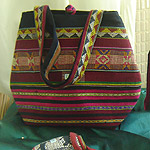

- Mats: for sitting on, or to kneel on when praying at the family altar or to wrap a gift for ceremonial occasions
- Covers or sheets or sleeping cloth
- Baby carriers to bind the baby to its mother’s back.

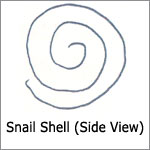
This craft is practiced mainly for the production of domestic products and manufacturing holders for agricultural produce. Items such as baskets, boxes, lampshades, curtain rings, trays and cycle baskets are produced under this craft. These products are highly useful for storing grains and other such items during the winter months and summer evenings with rain.
40 kilometers out of Kolkata in a small village, Baniban Jagdishpur of Howra district one will find the most exquisite wig-makers. Each wig is created over three days, starting from the procurement of wooden block in the shape of the head. Nylon net is nailed to this block and one by one strands of human hair are woven into the net. The edges are clipped, and hair spray a red-hot tongs give it the finishing touch by producing the ordered curls. The village as a community produces around 500 wings each month which are sent across the country. While an average worker earns Rs. 60 a day, a skilled craftsperson can earn twice that amount. This small-scale industry like various others is under the tight hold of the middlemen. Due to this and the lack of demand are causing the craft to dwindle and many of the youngsters are opting for other professions.



